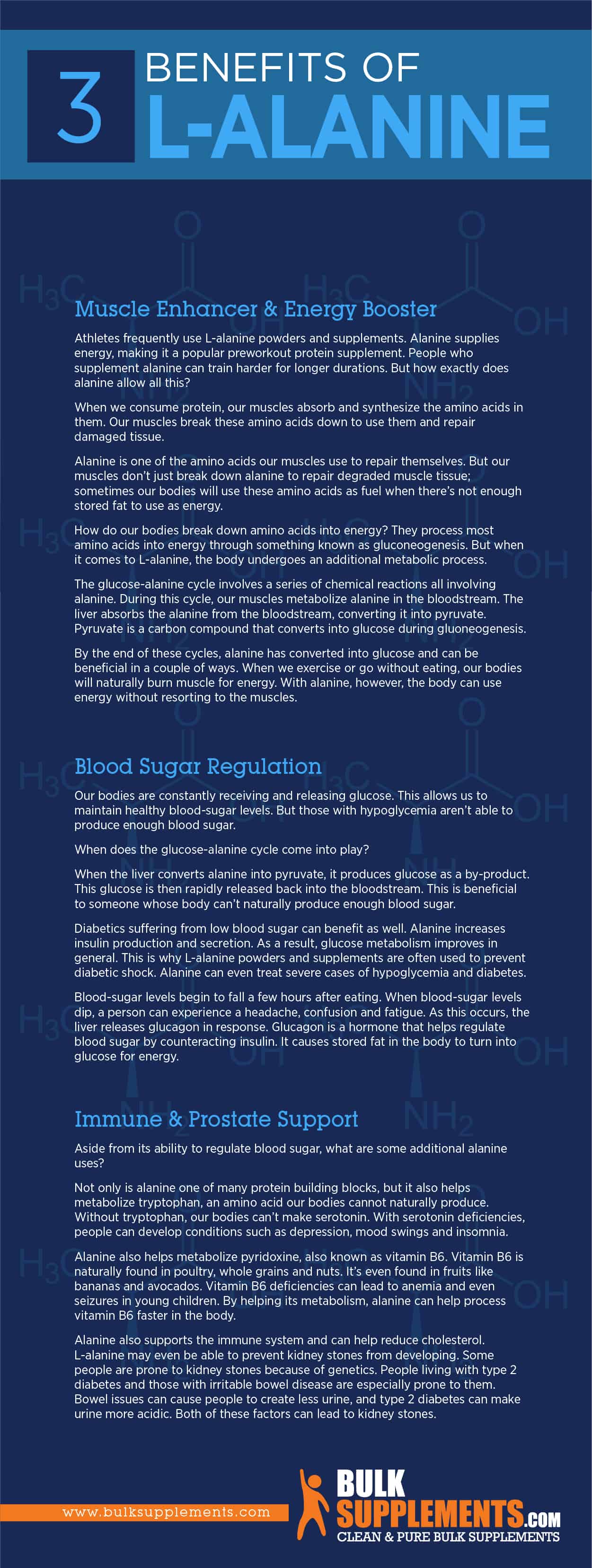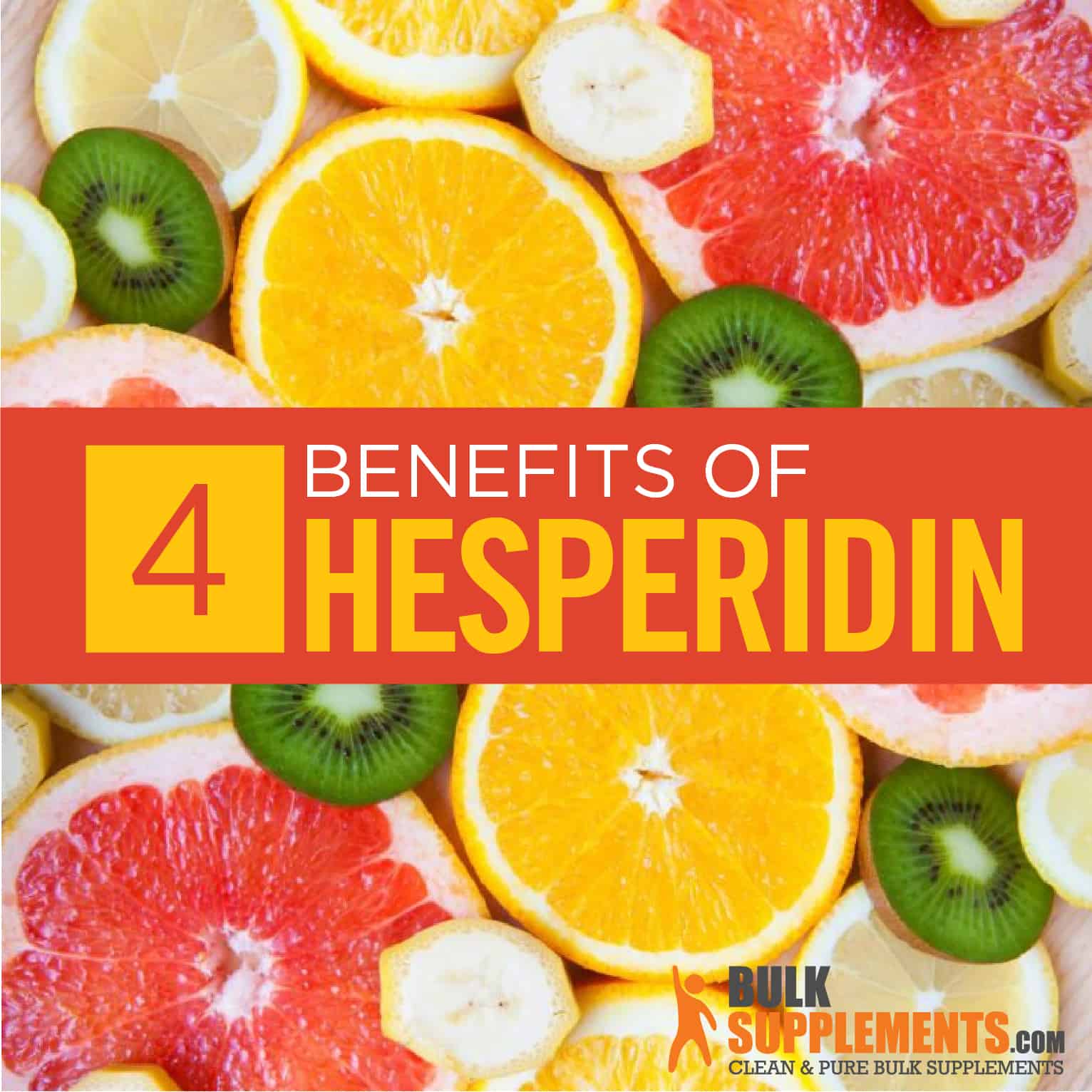L-Alanine: Benefits, Side Effects & Dosage
by James Denlinger Digital Marketing StrategistWe may not think too much about how our bodies absorb protein when we eat beef, chicken, tofu or eggs. We know that protein is good for muscles, but what exactly does it do for our muscles and our overall health?
When you consume protein, a series of chemical reactions occur throughout your body. These processes all involve an amino acid known as L-alanine. L-alanine is a nonessential amino acid often referred to as alpha-alanine, or simply alanine.
There are all types of alanine uses. It serves as a muscle repairer and source of energy, and it can even help the body manage blood-sugar levels. Those who get enough protein usually don’t have to worry about consuming enough alanine. But for athletes or people who struggle with low blood sugar, alanine can be a helpful supplement.
So, what exactly is alanine, and how does it interact with our bodies? What kinds of benefits do we experience when we consume alanine? How can alanine be helpful if you’re an athlete or suffer from low blood sugar?
L-Alanine Benefits
Muscle Enhancer & Energy Booster
Athletes frequently use L-alanine powders and supplements. Alanine supplies energy, making it a popular pre-workout protein supplement. People who supplement with alanine can train harder for longer durations. But how exactly does alanine allow all this?
When we consume protein, our muscles absorb and synthesize the amino acids in them. Our muscles break these amino acids down to use them and repair damaged tissue.
Alanine is one of the amino acids our muscles use to repair themselves. But our muscles don’t just break down alanine to repair degraded muscle tissue; sometimes our bodies will use these amino acids as fuel when there’s not enough stored fat to use as energy.
How do our bodies break down amino acids into energy? They process most amino acids into energy through something known as gluconeogenesis. But when it comes to L-alanine, the body undergoes an additional metabolic process.
The glucose-alanine cycle involves a series of chemical reactions all involving alanine. During this cycle, our muscles metabolize alanine in the bloodstream. The liver absorbs the alanine from the bloodstream, converting it into pyruvate. Pyruvate is a carbon compound that converts into glucose during gluconeogenesis.
By the end of these cycles, alanine has converted into glucose and can be beneficial in a couple of ways. When we exercise or go without eating, our bodies will naturally burn muscle for energy. With alanine, however, the body can use energy without resorting to the muscles.
This cycle also paves the way for one of the most important alanine benefits, which is its impact on blood sugar.
Blood Sugar Regulation
Our bodies are constantly receiving and releasing glucose. This allows us to maintain healthy blood-sugar levels. But those with hypoglycemia aren’t able to produce enough blood sugar.
When does the glucose-alanine cycle come into play?
When the liver converts alanine into pyruvate, it produces glucose as a by-product. This glucose is then rapidly released back into the bloodstream. This is beneficial to someone whose body can’t naturally produce enough blood sugar.
Diabetics suffering from low blood sugar can benefit as well. Alanine increases insulin production and secretion. As a result, glucose metabolism improves in general. This is why L-alanine powders and supplements are often used to prevent diabetic shock. Alanine can even treat severe cases of hypoglycemia and diabetes.
Blood-sugar levels begin to fall a few hours after eating. When blood-sugar levels dip, a person can experience a headache, confusion and fatigue. As this occurs, the liver releases glucagon in response. Glucagon is a hormone that helps regulate blood sugar by counteracting insulin. It causes stored fat in the body to turn into glucose for energy.
Alanine stimulates glucagon secretion when the body is in a fasting state. Eating can also help during a period when blood-sugar levels fall. But what if someone is unable to eat for several hours or throughout the night?
Alanine is especially helpful to hypoglycemics who won’t be able to eat for several hours. In one study, alanine raised glucose levels within 30 to 60 minutes. These results peaked and plateaued just under three hours.
Immune & Prostate Support
Aside from its ability to regulate blood sugar, what are some additional alanine uses?
Not only is alanine one of many protein building blocks, but it also helps metabolize tryptophan, an amino acid our bodies cannot naturally produce. Without tryptophan, our bodies can’t make serotonin. With serotonin deficiencies, people can develop conditions such as depression, mood swings and insomnia.
Alanine also helps metabolize pyridoxine, also known as vitamin B6. Vitamin B6 is naturally found in poultry, whole grains and nuts. It’s even found in fruits like bananas and avocados. Vitamin B6 deficiencies can lead to anemia and even seizures in young children. By helping its metabolism, alanine can help process vitamin B6 faster in the body.
Alanine also supports the immune system and can help reduce cholesterol. L-alanine may even be able to prevent kidney stones from developing. Some people are prone to kidney stones because of genetics. People living with type 2 diabetes and those with irritable bowel disease are especially prone to them. Bowel issues can cause people to create less urine, and type 2 diabetes can make urine more acidic. Both of these factors can lead to kidney stones.
Alanine is able to neutralize the insoluble toxins that cause kidney stones, and it’s especially helpful to those with family histories of kidney stone disease.
Alanine is also present in prostate fluid. This suggests that alanine may be able to protect against prostate enlargement. This condition can often cause frequent and painful urination. It can also cause urine retention. When combined with glycine and glutamic acid, alanine can reduce the size of the prostate and relieve nocturia, frequent urination and urgency. Another study suggests that alanine can inhibit prostate cancer cell metabolism.
 PIN IT
PIN ITFood Sources of L-Alanine
Our bodies naturally make nonessential amino acids. It’s not necessary to seek these amino acids out in our diet. If you eat enough protein every day, you shouldn’t have to worry.
L-alanine is present in dozens of lean protein sources. Here are some:
- Salmon (½ fillet): 2,380 milligrams
- Chicken breast (100 grams): 1,015 milligrams
- Hard-boiled egg (1 large): 350 milligrams
- Avocado (100 g): 109 milligrams
- Sunflower seeds (1 cup): 1,131 milligrams
- Plain whole milk yogurt (1 cup): 363 grams
- Whole almonds (1 cup): 1,469 milligrams
- Gelatin dry powder (1 tablespoon): 561 milligrams
To those suffering from low blood sugar, using alanine supplements can be beneficial. Of course, these supplements can also help those who don’t consume enough protein.
L-Alanine Side Effects & Dosage
L-Alanine Side Effects
Taking an alanine supplement is relatively safe in small doses. There are few to no reported alanine side effects. However, taking amino acid supplements in high doses may impair the kidneys, especially in those with chronic kidney disease.
Taking high amounts of L-alanine can be dangerous. Especially to those with tyrosine and phenylalanine deficiencies. Combining high doses of alanine can cause chronic fatigue syndrome. It may even make a person more susceptible to Epstein-Barr virus.
People with high blood sugar need to be careful when supplementing with alanine. If you have diabetes, it’s vital to monitor your blood sugars. Those with prostate inflammation and high blood pressure should avoid supplementing with alanine. People with blood sensitivities should avoid supplementing with alanine as well. Only supplement with alanine under the supervision of a doctor.
Alanine side effects for pregnant or breastfeeding women are unknown. Therefore, be cautious and avoid supplementing with L-alanine if you are pregnant or breastfeeding.
Dosage
The typical serving size of an alanine supplement is 2,000 milligrams. It’s best to take this dose 30 minutes prior to a workout. If you decide to use L-alanine powder, it’s best to mix it with juice, water or protein shakes.
Some with type 1 diabetes may struggle with low blood sugar due to too much insulin. These individuals should only take between 20 and 40 grams of alanine. They may also struggle with low blood sugar throughout the night. These individuals should take 40 grams of alanine at bedtime along with 10 grams of sugar.
If you struggle with low blood sugar, talk to your doctor about which dose of alanine you should take.
The Bottom Line
Amino acids all play a big role in our overall health. But L-alanine, in particular, helps our bodies in ways other amino acids cannot. Like other amino acids, alanine can help us maintain muscle mass and keep our energy levels up. But unlike other amino acids, alanine plays a crucial role in managing blood-sugar levels. It also supports the immune system and protects the kidneys and prostate.
Sponsor Ads
Created on Mar 31st 2020 17:00. Viewed 337 times.





